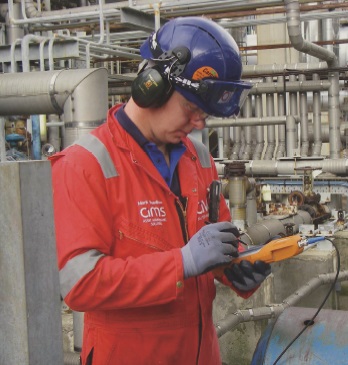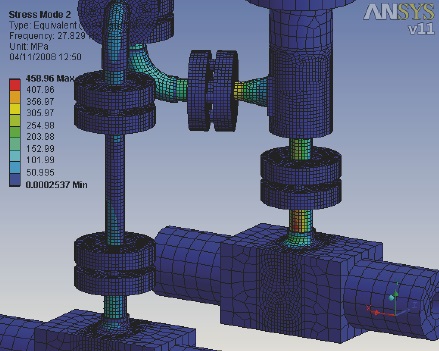Overcome pipework failure caused by pipework vibration and fatigue
According to data published by the UK’s Health & Safety Executive (HSE) for the offshore industry, vibration induced pipework failure accounts for 21% of all hydrocarbon releases. Data from individual plants in Western Europe suggests between 10 & 15% of pipework failures are caused by vibration induced fatigue.
How to overcome pipework failure due to vibration?
Neil Parkinson, Technical Director at asset integrity specialist AV Technology Ltd (AVT), explains the six phases in understanding, correcting and preventing vibration-induced pipework failure.
Proactive Vs Reactive pipework assessments
The Energy Institute guidelines break down into two main scenarios – proactive and reactive assessments – and aim to ensure compliance with statutory duty, improve safety and reliability, reduce liability from leakeage, and minimise plant downtime.
Proactive assessments can be used to routinely evaluate all pipework on a site, whether existing or planned, to ensure that best practice has been adopted and to identify possible areas of concern.
Reactive assessments follow, and are used to further investigate known vibration issues or troubleshoot actual failures within both mainline pipework as well as small bore connections (SBCs).
Six phases to pipework vibration assessments

There are six key phases to achieving pipework vibration assessments in line with requirements of the guidelines:
- Qualitative assessment
- Visual assessment
- Basic vibration monitoring
- Specialist measurement techniques
- Specialist predictive techniques
- Corrective actions
Qualitative assessment of pipework
The qualitative assessment phase is perhaps the most challenging to implement and involves numerous calculations for assessing the likelihood of encountering a vibration-induced fatigue issue. This assessment takes into account many relevant factors, from fluid energy, flow velocities and cyclic operation to the construction quality of infrastructure including process machinery and types of valves. It also assesses the chance of flashing or cavitation, and includes a calculation process for scoring likely excitation factors – which are combined with conditional and operational factors to predict the ‘likelihood of failure’ (LOF) for each pipe branch.
Visual inspection of Pipework
Visual inspection is a quick and effective method for identifying potential areas for concern. Many pipework vibration problems are simply the result of operators not following recommended good practice, and visual inspection by skilled assessors can quickly flag up areas for improvement relating to pipe infrastructure. This may include installing more effective pipe supports or replacing worn or damaged supports, proper bracing of SBCs, avoiding fretting and poor geometry, and allowing for thermal expansion of tubing.
Basic vibration monitoring
The basic piping vibration measurement phase identifies areas of concern based on measured values of pipework vibration. In this phase specialist engineers will first use a single axis accelerometer connected to a portable data collector to take initial vibration levels, ranging from 1 Hz up to 300 Hz. These measurements are presented as vibration amplitude versus frequency and enable the vibration to be classified as acceptable, concern or problem, based on comparison with assessment criteria in the Energy Institute guidelines.
Specialist measurement techniques
Specialist measuring techniques are used if vibration is assessed as being at a concern or problem level, or for pipework with a higher frequency vibration of more than 300 Hz. Here, a variety of more in-depth tests can be deployed depending on need, including: dynamic strain measurement and fatigue analysis; experimental modal analysis; operating deflection shape analysis; and dynamic pressure (pulsation) measurement.
Specialist predictive techniques

Engineers can implement specialist predictive techniques, applying sophisticated tools and modelling to provide a more detailed assessment of the dynamics of specific pipelines throughout their lifecycles. A high percentage of the work carried out by our own special projects division is concerned with on-site measurements of dynamic strain and vibration data, using multi-channel instrumentation systems together with the previously measured data. Specialist predictive techniques include finite element analysis (FEA), computational fluid dynamics, and pulsation and surge analysis.
Corrective actions to reduce vibration-induced fatigue
The final stage of any pipework assessment is to recommend corrective actions to reduce vibration levels and the likelihood of future vibration-induced fatigue failures. These actions vary from improving the support infrastructure around pipework including bracing and dampening, or modifying the process conditions themselves to reduce fluid loadings.
Training on pipework failure due to vibration
Practical, on-site training is advised to ensure all necessary measures are taken to prevent major accidents and to ensure obligations under the COMAH regulations and European Directive 96/82/EC are met.
AV Technology provides training at a number of different levels:
- Raise awareness of the causes and consequences of vibration induced fatigue failures in pipework.
- Raise competence of existing staff to be able to perform pipework vibration assessments
- Raise competence of existing staff to be aware of the good practice guidelines and to be able to implement corrective actions for many common problems.
By learning best practice you will be well placed to help reduce the risks of leakage to as low as reasonably practicable.
To learn more about the topic of vibration-induced pipework failure, read this in-depth report by AV Technology Ltd.
Get the latest process industry news
Interested in receiving even more industry-leading news from Process Industry Forum delivered directly to your inbox? Then sign up to our free newsletter. Bringing you the latest news, trends, innovations and opinion from across the process industry, our exclusive newsletter gives you all the industry insights of the moment in one, easy-to-digest bulletin. Stay ahead of the competition with regular process industry news instalments from PIF.

